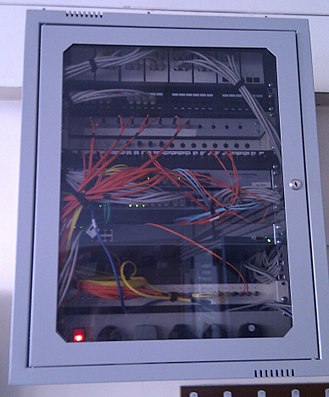Fiber-optic communication
Fiber-optic communication is a method of transmitting information from one place to another by sending pulses of light through an optical fiber. The light forms an electromagnetic carrier wave that is modulated to carry information. Fiber-optic communication has revolutionized the telecommunications industry, enabling high-speed data transmission over longer distances with minimal loss of signal quality compared to traditional wired communications like copper cables.
History
The development of fiber-optic communication can be traced back to the 19th century, with early experiments in guiding light through transparent rods for optical signaling. However, it wasn't until the 1960s and 1970s that key technological breakthroughs, such as the invention of low-loss optical fibers and the laser, made fiber-optic communications practically viable. The first commercial fiber-optic communication system was installed in 1977, and since then, the technology has evolved rapidly, becoming the backbone of modern internet and global telecommunications networks.
Principles of Operation
The core principle behind fiber-optic communication involves transmitting light signals down a fiber made from glass or plastic. These fibers are incredibly thin, slightly thicker than a human hair, and are capable of guiding light over long distances with remarkably low loss. The key components of a fiber-optic communication system include the transmitter, which generates the light signal; the optical fiber, which carries the signal; and the receiver, which decodes the light signal back into data.
Transmitter
The transmitter converts electrical signals into light signals, typically using a laser or a light-emitting diode (LED). The light is then modulated, encoding the data onto the light wave by varying its intensity, phase, or wavelength.
Optical Fiber
The optical fiber acts as the medium through which the light signal travels. It consists of a core surrounded by a cladding layer, with the core having a higher refractive index, enabling the light to be guided along the fiber through total internal reflection.
Receiver
At the receiving end, the light signal is converted back into an electrical signal by a photodetector, such as a photodiode. The electrical signal can then be processed to retrieve the transmitted data.
Advantages
Fiber-optic communication offers several advantages over traditional copper wire communications, including:
- Higher bandwidth, allowing for the transmission of more data at higher speeds.
- Longer transmission distances without the need for signal boosters, due to lower attenuation.
- Immunity to electromagnetic interference, making fiber-optic cables ideal for environments with high electromagnetic activity.
- Greater security, as fiber-optic cables are difficult to tap without being detected.
Applications
Fiber-optic communication is used in a wide range of applications, including:
- Internet and broadband services, providing high-speed internet access to homes and businesses.
- Telecommunications networks, forming the backbone of global communications infrastructure.
- Cable television, delivering high-definition video content.
- Military and space applications, where secure and reliable communication is critical.
Future of Fiber-Optic Communication
The future of fiber-optic communication looks promising, with ongoing research focused on increasing the capacity and efficiency of fiber-optic networks. Technologies such as dense wavelength division multiplexing (DWDM) are enabling the transmission of multiple signals simultaneously on the same fiber, significantly increasing the data capacity of fiber-optic cables. Additionally, advances in materials science are leading to the development of fibers with even lower loss and higher bandwidth capabilities, promising to further enhance the performance of fiber-optic communication systems.
This communication related article is a stub. You can help WikiMD by expanding it.
Transform your life with W8MD's budget GLP-1 injections from $125.
W8MD offers a medical weight loss program to lose weight in Philadelphia. Our physician-supervised medical weight loss provides:
- Most insurances accepted or discounted self-pay rates. We will obtain insurance prior authorizations if needed.
- Generic GLP1 weight loss injections from $125 for the starting dose.
- Also offer prescription weight loss medications including Phentermine, Qsymia, Diethylpropion, Contrave etc.
NYC weight loss doctor appointments
Start your NYC weight loss journey today at our NYC medical weight loss and Philadelphia medical weight loss clinics.
- Call 718-946-5500 to lose weight in NYC or for medical weight loss in Philadelphia 215-676-2334.
- Tags:NYC medical weight loss, Philadelphia lose weight Zepbound NYC, Budget GLP1 weight loss injections, Wegovy Philadelphia, Wegovy NYC, Philadelphia medical weight loss, Brookly weight loss and Wegovy NYC
|
WikiMD's Wellness Encyclopedia |
| Let Food Be Thy Medicine Medicine Thy Food - Hippocrates |
Medical Disclaimer: WikiMD is not a substitute for professional medical advice. The information on WikiMD is provided as an information resource only, may be incorrect, outdated or misleading, and is not to be used or relied on for any diagnostic or treatment purposes. Please consult your health care provider before making any healthcare decisions or for guidance about a specific medical condition. WikiMD expressly disclaims responsibility, and shall have no liability, for any damages, loss, injury, or liability whatsoever suffered as a result of your reliance on the information contained in this site. By visiting this site you agree to the foregoing terms and conditions, which may from time to time be changed or supplemented by WikiMD. If you do not agree to the foregoing terms and conditions, you should not enter or use this site. See full disclaimer.
Credits:Most images are courtesy of Wikimedia commons, and templates, categories Wikipedia, licensed under CC BY SA or similar.
Contributors: Prab R. Tumpati, MD




